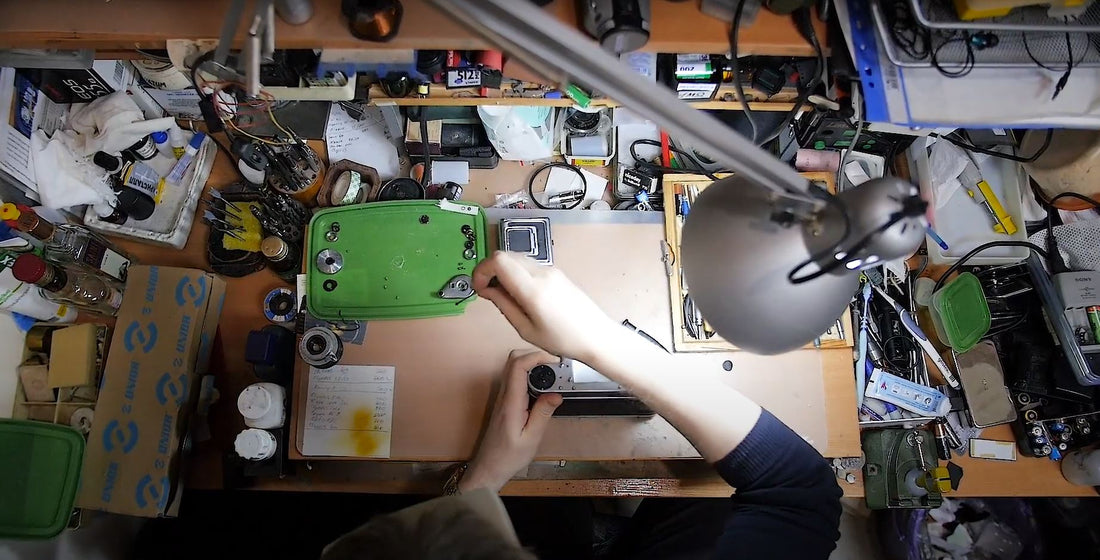
Problems and solutions with the power supply of analogue cameras
Share
There are hardly any new analogue cameras anymore, so most of us want and have to use cameras that are sometimes up to 50 years old. Unfortunately, that also means the cameras don’t always work reliably. If you bought and inserted a new battery and/or battery adapter and are having problems with your camera, you can first read here. We have compiled the most common problems and possible solutions for you. If your problem is not listed here or you need further help, feel free to contact us!
Why are batteries advertised as 1.35V (or 1.2V), but the packaging says 1.45V?
Zinc-air batteries have a voltage of 1.45V, which drops to 1.35V under load. The problem with alkaline batteries (1.5V) is not that the voltage is a bit too high, but that it varies greatly over time. For example, the voltage of new alkaline batteries is about 1.6V and then eventually drops to 1.2V (which distorts the results).
Nickel-metal hydride batteries (NiMh), like the Varta V80H, have 1.2V, which is less than the 1.35V of the previously used PX625 mercury batteries. Generally, you have to say that a lower voltage is usually less problematic when used in analogue cameras than a too high one, because a lower voltage (in this case only 0.15V) leads to slight overexposure (about 1/3 exposure values - EV) and negative film easily tolerates overexposures of 3-5 EV without it showing up during development or printing. With slide film, 1/3 EV can already be noticeable. So if you use slide film and have problems with under- or overexposed films, you might consider using an expensive adapter with a diode (or even having your camera fitted with a diode to adjust the voltage).
Batteries drain within a few hours to days?
Most analog cameras are very power-efficient, so the batteries we sell should last 2-6 months depending on usage. If the batteries drain within a few hours or days, this indicates something is wrong with your camera's electronics (old circuits often have problems with so-called “leakage currents”). These leakage currents can usually only be fixed by replacing the electronics, which is extremely complex and rarely economically viable, and also brings the problem that you replace old electronics with other old electronics that sooner or later can develop the same problem. In this case, the easiest solution is to buy another camera.
Camera does not respond, and the light meter does not move?
-
The most common problem - No contact:
a) First, scrape the contacts free of oxidation residues and old battery fluid with a metallic object like a flathead screwdriver or key, then clean them with distilled water (glass cleaner also helps)
b) Sometimes the spring of the battery compartment cover does not have enough tension to press the battery against the contact in the camera. In this case, use a screwdriver or something similar to bend the spring a little. This problem occurs especially with the Rollei 35 series.
- If none of this helps, your camera might be defective. Check (if available) whether other electronic functions like the self-timer or the LEDs in the viewfinder work. If not, the problem might be with your camera. Some mechanical cameras only need the battery for the light meter or the flash. If that's the case, you can simply use your camera with an external light meter (e.g. from Keks, TTArtisans or ReveniLabs) or a light meter smartphone app.
- Sometimes the adapter fits into the battery compartment but does not make proper contact with the battery contacts. Check if in your camera's battery compartment the contact:
a) Contact taken from top and bottom (then a simple rubber O-ring adapter also works)
b) Or, whether the contact is taken from the top and one side (then you need an adapter made of conductive plastic or metal)
Camera works with 1.5V or 6V batteries, but not with the supplied 1.35V or 5.6V?
Many users are used to using alkaline batteries with a higher voltage than intended for the camera. Depending on the camera, this leads to distorted results in the exposure measurement (usually overexposure due to too high voltage).
When you then switch to our actually better-suited (because more accurate exposure measurement) battery options, it sometimes happens that the camera does not work with our batteries, even though it does with alkaline batteries.
The reason usually lies in the fact that the electronics in the camera have aged over time and require more voltage than originally intended to work correctly. In the best case, the two negative effects of too much voltage and old camera electronics cancel each other out so that your exposure measurement more or less fits and you can simply continue using your camera as before.
Ordered the wrong battery?
Sometimes, despite careful research, you order the wrong battery and only realize it when you see it doesn’t fit into the camera compartment. This is understandable given the overwhelming number of different battery formats.
If this has happened, then of course it’s no problem. Visit our website www.ausgeknipst.de and click on the magnifying glass icon. Simply type your camera model into the search field (e.g., “Canon AE-1”) or alternatively search the internet for "camera model + battery" or "camera model + manual" and download the manual as a .pdf. Then search the manual for the keyword “battery.”
We now have a solution for almost all batteries. If you can't find anything, feel free to leave us a message and we'll come up with a solution together.
Light meters show incorrect readings despite fresh batteries?
1. If you use zinc-air hearing aid batteries (type 675 or p312), you should know that they react with air. Therefore, let them sit in the air for 5 minutes before inserting them.
2. Otherwise, it may of course be that the light meter or the electronics of your camera are defective or not properly set (unfortunately, this is quite common given the age of the cameras).
It's best to compare the values with a good light meter (e.g., from a modern SLR or mirrorless camera) and adjust the light meter of your analog camera if necessary using exposure compensation or the ISO dial.
Return and disposal of batteries and accumulators
According to § 18 of the Battery Act, we must inform you as a consumer that you are legally obliged to dispose of batteries and accumulators properly. Used batteries must not be disposed of in household waste! Batteries containing hazardous substances are marked with a symbol consisting of a crossed-out trash bin and the chemical symbol (Cd, Hg, or Pb) of the heavy metal responsible for the classification as hazardous. You can return them after use to a municipal collection point or to local retailers. The accumulators and batteries we sell can also be sent back to us free of charge for environmentally friendly disposal.



1 comment
Ja, die beiden Tüftler haben Sachverstand und Lösungen parat. Für uns Fotofreunde ist „ausgeknipst“ eine gute Adresse. Ich sammle über 40 Jahren Fotoapparate. So manches Teil kann zum Leben erweckt werden. Wie z.B. meine Rollei 35 S mit der neuen Batterie Varta V 80 H und dem genialen Lader von den beiden Tüftlern. Bei wenig benötigter Spannung zeigt der interne Belichtungsmesser ein korrektes Ergebnis an. Möchte mit dieser Kamera den Ilford XP2 belichten. Hat einen großen Puffer im Belichtungsbereich.
Auch für meine Pentax 17 Halbformat ist die Sonnenblende mit Filtergewinde 46 mm von „ausgeknipst“ erste Sahne!
Eine gute innovative Adresse für Lösungen !
Gut Licht! DILA